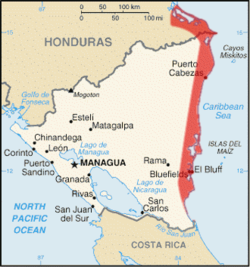When we returned to Managua from Puerto Cabezas, a guard in the hotel began to ask Michelle questions, such as "Why were you in Puerto Cabezas?" and "What were you doing there?". I think brother Dayton cleared everything up. Later, we discovered that these two sides of the country are politically separate. In the map below, there are two large pink regions: North Atlantic Autonomous Region (R.A.A.N) and South Atlantic Autonomous Region (R.A.A.S). Both of these regions have their own autonomous government with governors and regional councils. Defense is the responsibility of the Central Government of Managua.


Much of the R.A.A.N is called the Mosquito (or Miskito) coast, named after the Miskito Indians that reside here. You can see this area highlighted in red in the map above. The R.A.A.N. has never fully been incorporated into the nation of Nicaragua. It is isolated from Western Nicaragua by rugged mountains and dense tropical rain forest. There are no paved roads from coast to coast. The Miskito Indians are a different people from the Mestizos of the West, whom they call "the Spanish." The primary language is Miskito, and many speak Spanish as a secondary language. Traditionally, the natives do not regard themselves as Nicaraguans, and some see Nicaraguan rule as a foreign imposition.
The five major cities of R.A.A.N. are Puerto Cabezas (capital), Waspam (by Honduran border), and the "mining triangle towns" of Bonanza, Rosita, and Suina. There are also many towns and villages along the rivers. As we learn more about the geography and people of Nicaragua, we can gain a better understanding of which of these areas do and do not have a gospel witness. The picture below is one such town called Layasiksa, which in 2004, was described as having no running water, electricity, or phones and having 136 families. It is easy to get so caught up in our own world, and forget that there are those who still have not yet heard the name of Christ. They do not know that there is a mediator between God and man who has shed their blood for their sins. "How then shall they call on Him whom they have not believed? and how shall they believe on Him whom they have not heard? and how shall they hear without a preacher?"

No comments:
Post a Comment
Note: Only a member of this blog may post a comment.